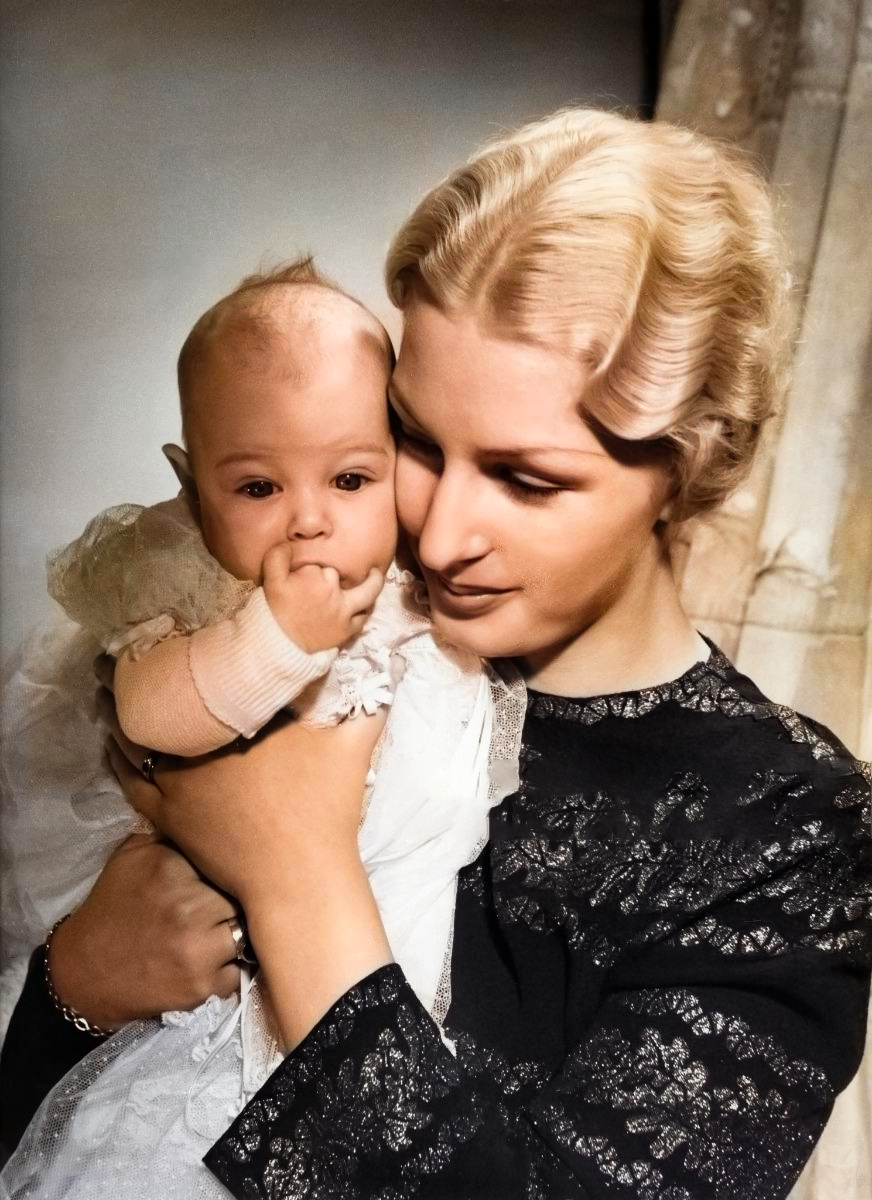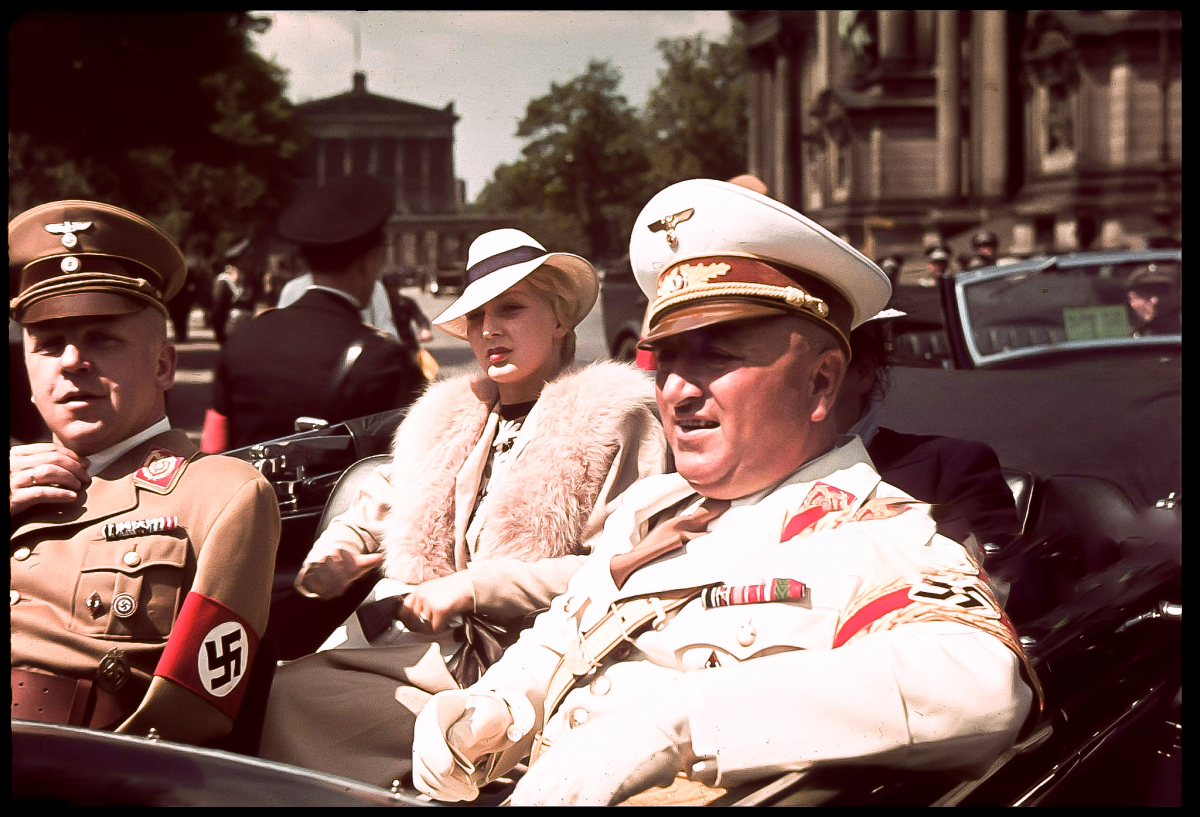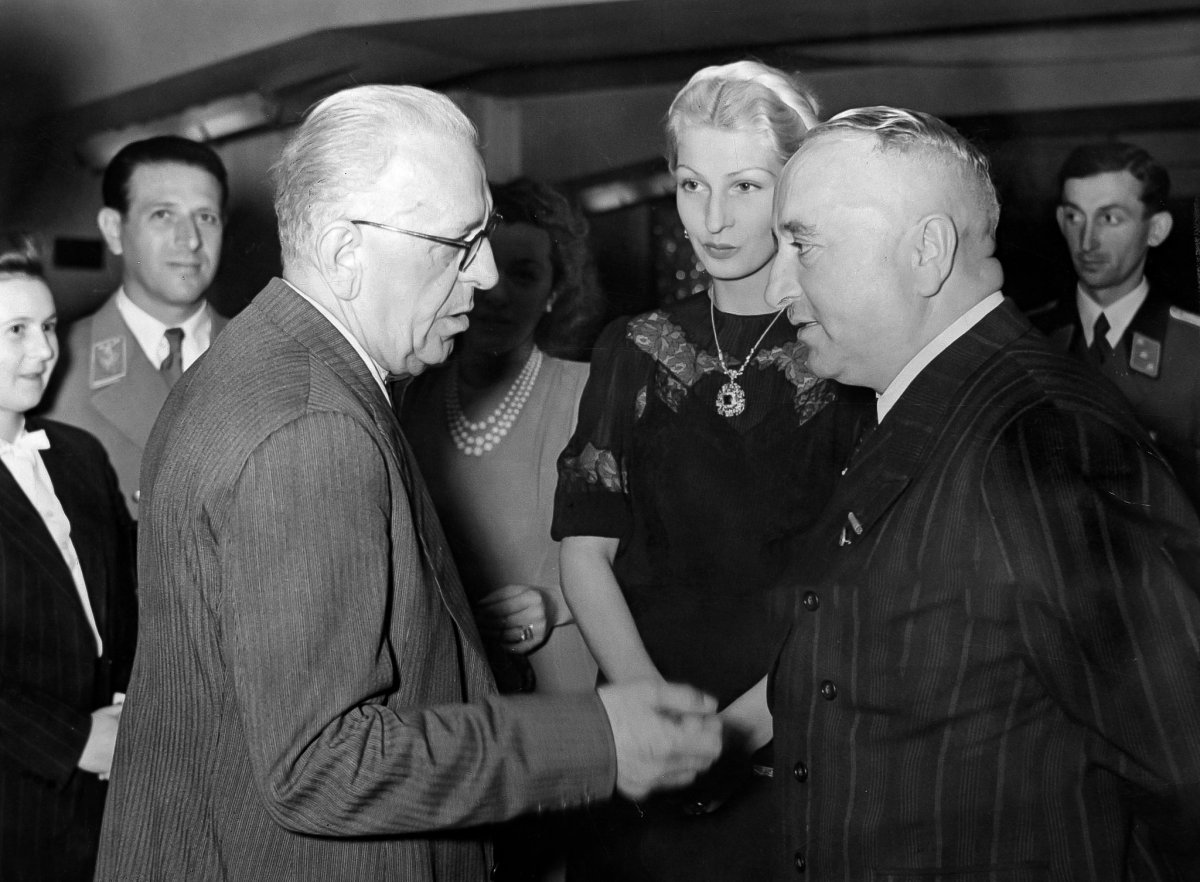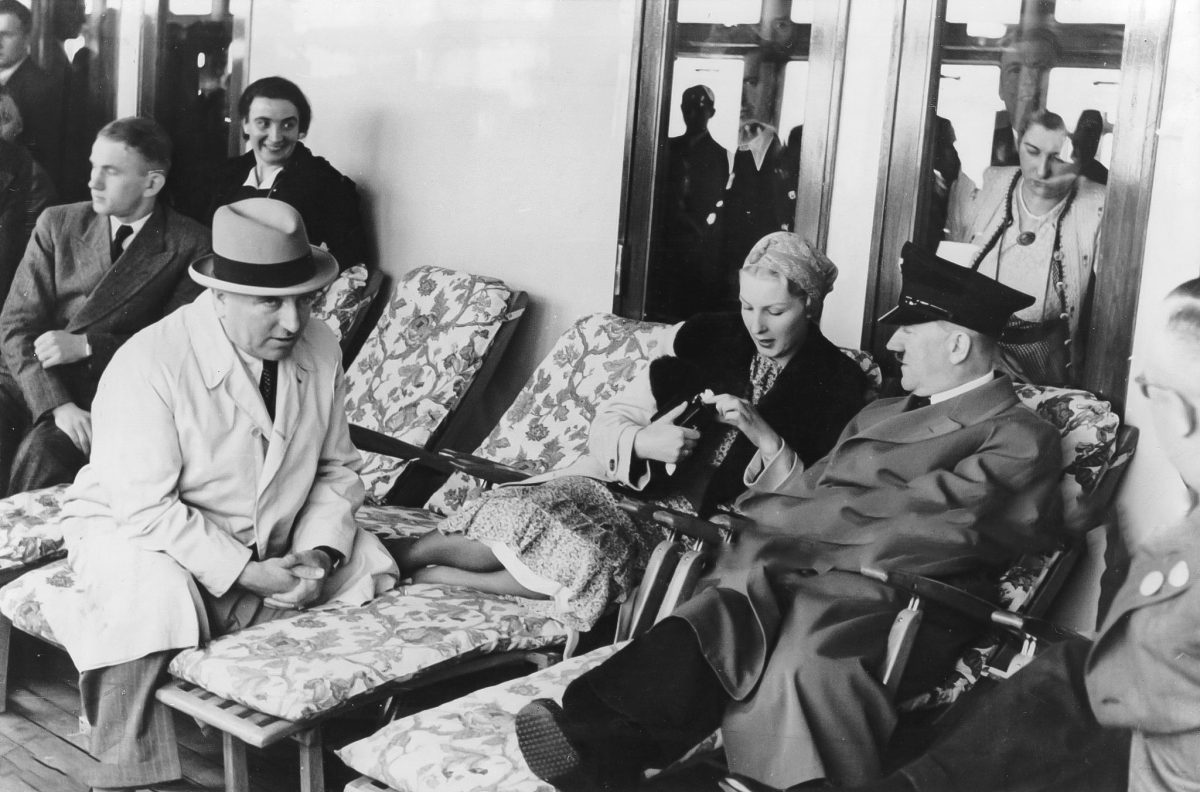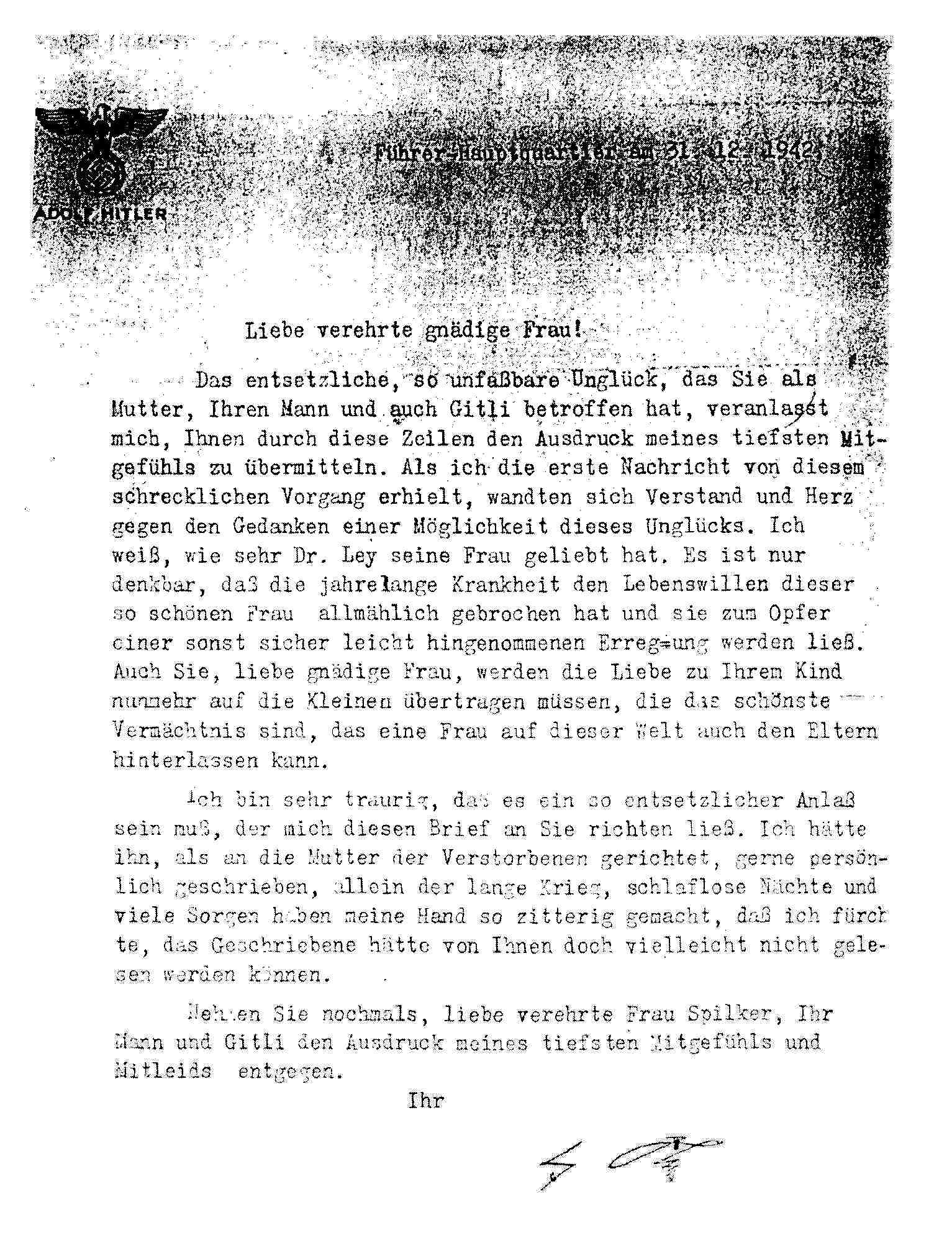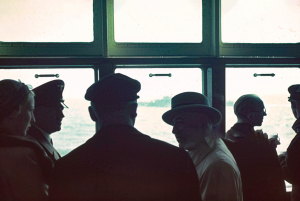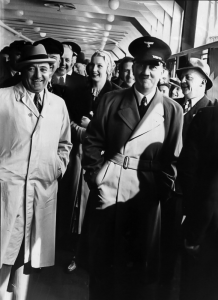History
Inga Ley was born on March 8, 1916 as Inga Ursula Spilcker in Wroclaw, Poland (at the time the German city of Breslau). Inga was the daughter of the opera and concert singer Max Spilcker and his wife Lory “Lore” Franzisker Spilcker, born Kotz, who was also an opera singer.
Inga and her younger sister
Inga and her younger sister Gittli were given voice training lessons by their parents. In 1935, Inga, with her fine mezzo soprano voice, was performing at the Friedrichstadt-Palast, Berlin when she met her future husband Robert Ley for the first time.
The young Inga, who had grown up to extraordinary beauty, was courted by him, presented with flowers after the performances, and finally invited by him to receptions and travels. At such a reception in 1936 Inga was introduced to Hitler, who was also impressed by the beautiful singer.
Robert Ley
In 1936 she took part in a trip to Italy with Robert Ley, in 1937 on a Baltic Sea voyage with one of the KdF ships, and ” word spread around” about Inga and Robert Ley afterwards.
Inga, a rather restrained young woman, returned the love of this 26-year older and powerful man in the party hierarchy, and apparently both began planning for a common future at least since 1937. They were married a year later on 20 August 1938.
NSDAP Reichsleiter Dr. Robert Ley was the leader of the Deutsche Arbeitsfront (German Labour Front). It was Robert Ley’s second marriage. He was 26 years older than Inga at the time and the marriage was not a happy one. The honeymoon took place on the KDF (Kraft Durch Freude, Strength Through Joy) ship “Robert Ley”. Hitler was also there with other High ranking Nazi figures.
She was very much admired by Hitler and often took refuge from her husband’s heavy drinking by staying at Hitler’s mountain retreat in the Obersalzberg.
There were three children born from the marriage: Lore (born October 25, 1938), Wolf (born May 14, 1940) and Gloria (born June 27, 1941)
The Leys first lived in their villa in Berlin, Herthastraße 13/15. Adolf Hitler was a frequent visitor, sometimes visiting them twice a week. On January 1 1936 Robert Ley bought a large country estate, which included a farm, in Gut Rottland which is located in Waldbröl near Gummersbach. In 1940 Ley received from Adolf Hitler a monetary gift worth one million Reichsmarks, which he used to finance the farm. Inga liked to stay in Gut Rottland to get away from the hectic daily routine in Berlin. However Berlin remained the centre of her life as it was where her husband worked and where her friends were. The staff was expanded to include a nanny and a nurse. Like her parents, Inga had a hospitable house; Artists and political celebrities came to visit. Adolf Hitler was one of the regular guests of the Leys, sometimes he came twice a week.
Between 1938 and 1942, we often found the Leys to be welcome guests at various receptions and events, and it was always Inga Ley who drew admiring glances from the participants.
Her husband enjoyed the brilliance that Inga spread, all the more as some rays fell back on him. The luck would have been perfect if Inga had not suffered from a health handicap.
Every since Inga graduated from the High School, Inga had been plagued with recurring bile colic (gallbladder attacks). Her condition was further affected by the fact that she had to undergo an appendectomy during her pregnancy with Lore. As Robert Ley reported in his Nuremberg Interviews: the bile colic, began then and continued from then on even more often. To combat the pain, the doctors used morphine, of which Inga became dependent over the years.
Under the pseudonym Inga Hansen, in Januari 1941 Inga Ley wrote a children’s book – Es War Einmal, kleine Märchen für kleine Leute – (Once Upon a Time, Little Fairy Tales for Little People). She illustrated the book herself. The neat little and very rare book was red linen bound (with title embossed in gold) and was reissued again in 1943 in two gold embossed different colors (green end red) (the illustrations and versions from this book can be found in photo album 3)
In March 1941, when she was five months pregnant, Inga suffered a bad accident while riding in her carriage near Waldbröl. While riding near the “Brölbähnchen” railway line a whistle from an approaching train startled the horses. Inga was thrown out of the carriage and suffered a miscarriage. She was immediately flown to a hospital in Berlin. The baby survived the accident unscathed and was born prematurely three months later on June 27 1941. To celebrate the German forces early victories in Russia (Operation Barbarossa) the baby was named Gloria. While in hospital Inga was given morphine for pain relief which she was soon to become dependent on for the remainder of her short life.
Worried about the allied bombing raids on Berlin, Inga moved permantly to Gut Rottland at the end of 1941. After living a cultured life in Berlin, Inga found living on a farm away from her husband to be quite a challenge. She was not accepted by the estate’s administrative staff and missed her husband who spent most of his time in Berlin. She continued to seek refuge in morphine came addicted and in May 1942 she was admitted to a sanatorium in San Remo for treatment. The treatment was unsuccessful and in August and October 1942 she was in another sanatorium, this time in Berlin. Her state of mind was badly damaged and she was suffering from severe cramps.
In the last days of 1942, Inga left Berlin and returned to Gut Rottland. There were many Poles, Ukrainians and Russian prisoners of war working on the farm so handguns were issued to protect Inga and her staff from possible attacks. Robert Ley was at Gut Rottland in December that same year and was under orders to reported to the Führer headquarters, Wolfsschanze before the end of the year. Those last days at Gut Rottland were later described by witnesses as not very harmonious. Inga Ley’s depressive mood, coupled by the bad military situation in Russia (Stalingrad) made Robert Ley nervous and irritable.
Ley planned to leave Gut Rottland with Otto Marrenbach for the Führer headquarters on December 29 at 6 o’clock in the evening. According to Robert Ley’s private secretary, Hildegard Brüninghoff, while they were waiting downstairs for the company car, Inga Ley went up to her bedroom on the first floor and shot herself. Ley and Marrenbach ran to the upper floor and tried to open the locked bedroom door. After forcing the door open they found Inga laying across her bed with a single shot to the forehead. She had committed suicide. She was driven to it by loneliness, her dependency on pain killing drugs following complications during childbirth and her husband’s upcoming departure. She was 26 years old when she died. She was buried in the oak grove (see the Ahnenhain auf Rottland photo album) adjacent to her home in Gut Rottland. (Robert Ley ordered that Inga’s parents (Max Spilcker and his wife Lore) be granted custody of their three children.
A farewell letter was found which proved that Inga had been planning suicide for some time. Her husband’s upcoming departure was the trigger that brought it on.
Adolf Hitler was deeply moved when he heard of the death of Inga Ley. He wrote her mother a letter of condolence which is very revealing and gives an insight into his state of mind.
As for Robert Ley, he increasingly devoted his time to “womanising and heavy drinking.” A few months after his wife’s death, in March 1943, he took a mistress. Ley did not marry his mistress because he was afraid of ridicule as she was 18 years old and he was 54 at the time. This, however, did not prevent her from bearing him a child, which was delivered in September 1944.

